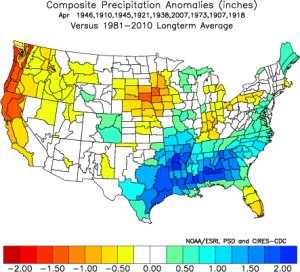What follows a warm March in Illinois? Out of curiosity I looked at the other nine years in the list of 10 warmest months of March on record in Illinois (earlier post). First, I looked at the temperature and precipitation patterns for April. Then I looked at the May-August period as the heart of the growing season. Here are the results.
Disclaimer: while past years can give some insight on how the atmosphere has behaved over Illinois, they are not always the best forecast for the upcoming month, season, or year. Each new year brings a unique set of circumstances that causes things to play out differently than any previous year.
April
Historically, a warm March has been followed by a colder-than-normal April on average (first map). That’s true not just in Illinois but across the U.S. On the other hand, precipitation for those same April periods was a mixed bag in Illinois (second map). Most of the state was near-normal while west-central Illinois was slightly wetter-than-normal. It is interesting that dryness shows up in Minnesota, Iowa, Nebraska, and South Dakota – an area having trouble with drought this year.


May – August
The period from May through August is the core of the growing season in Illinois. Rather than produce temperature and precipitation maps of each month, I considered the entire May-August period in one set of maps. One popular question I get is “Does this warm weather now mean that we will get a hot summer?” At least historically, the growing season following a warm March does not show a pattern of above-normal temperatures. On average, they have been remarkably mild in temperature. There is a tendency towards below-normal precipitation across much of Illinois and the Midwest. It’s nothing catastrophic, on average just an inch below normal in parts of eastern and northern Illinois. Meanwhile, southern Illinois is in an area of slightly above-normal precipitation.


One last note, using an average of several years together may cover up any kind of bipolar personality where half the summers were extremely hot and half the summers were extremely cold. I did not seeing anything like that in this analysis. For example, in the nine cases of the growing season temperatures, four were slightly cooler than normal, two were near normal, two cases slightly warmer than normal, and only one case (1921) was well above normal (i.e., hot).


0 Replies to “What Follows a Warm March?”